Bible translations into German
German language
Pre-Lutheran Germanic Bibles

The earliest known and partly still available
Printed Bibles
There is ample evidence for the general use of the entire vernacular German Bible in the fifteenth century.
The Sensenschmidt Bible was published around 1476‒1478. In 1478–1479, two editions were published in
In 1477, in Delft, Holland, an Old Testament (except the Psalms) was printed in Middle Dutch. An accompanying New Testament seems to have been lost.
In total, there were at least eighteen complete German Bible editions, ninety editions in the vernacular of the Gospels and the readings of the Sundays and Holy Days, and some fourteen German Psalters by the time Luther first published his own New Testament translation.
Overview of the German Bibles before Luther
| Name | Year | Place of printing | Printer/Illustrator | Chronological order |
| Mentelin-Bibel | 1466 | Straßburg | Johannes Mentelin | 1. |
| Eggestein-Bibel | vor 1470 | Straßburg | Heinrich Eggestein | 2. |
| Zainer-Bibel | 1475 | Augsburg | Günther Zainer | 3./4. |
| Pflanzmann-Bibel | 1475 | Augsburg | Jodocus Pflanzmann[6] | 4./3. |
| Sensenschmidt-Bibel | 1476–78 | Nürnberg | Andreas Frisner, Johann Sensenschmidt | 5. |
| Zainer-Bibel | 1477 | Augsburg | Günther Zainer | 6. |
| Sorg-Bibel | 1477 | Augsburg | Anton Sorg | 7. |
| Kölner Bibeln | 1478/79 | Köln | Heinrich Quentell oder Bartholomäus von Unckell | Low Rhenish
|
| Kölner Bibeln | 1478/79 | Köln | Heinrich Quentell oder Bartholomäus von Unckell | Low Saxon
|
| Sorg-Bibel | 1480 | Augsburg | Anton Sorg | 8. |
| Koberger-Bibel | 1483 | Nürnberg | Anton Koberger | 9. |
| Grüninger-Bibel | 1485 | Straßburg | Johann Grüninger | 10. |
| Schönsperger-Bibel | 1487 | Augsburg | Johann Schönsperger d. Ä. | 11. |
| Schönsperger-Bibel | 1490 | Augsburg | Johann Schönsperger d. Ä. | 12. |
| Lübecker Bibel (1494) | 1494 | Lübeck | Steffen Arndes/Meister der Lübecker Bibel | Low Saxon |
| Otmar-Bibel | 1507 | Augsburg | Johann Otmar | 13. |
| Otmar-Bibel | 1518 | Augsburg | Silvan Otmar | 14. |
| Halberstädter Bibel | 1522 | Halberstadt | Lorenz Stuchs | Low Saxon |
Luther's Bible
The most important and influential translation of the Bible into German is the Luther Bible, completed in 1534. It was the first translation (mainly) from the original Hebrew and Greek and not translated from the Latin Vulgate.[7] The influence that Martin Luther's translation had on the development of the German language is often compared to the influence the King James Version had on English. The Luther Bible is currently used in a revised version from 1984, which was adapted to the new German orthography in 1999. Here also some revisions have taken place, e.g. "Weib" > "Frau". Despite the revisions, the language is still somewhat archaic and difficult for non-native speakers who want to learn the German language using a German translation of the Bible. Another revision was published in 2017; in this version, some of the text that had been 'toned down' in previous revisions has been reverted to Luther's stronger formulations.
Other translations after Luther's
Froschauer Bible
Catholic
Catholic translations continued to be produced: in 1526, Beringer's translation of the New Testament was published at
Mendelssohn
Later Bible translations
A
Daniel Gotthilf Moldenhawer's translation was published in 1774, Simon Grynaeus' in 1776, and Vögelin's of the new testament in 1781.
Heinrich Braun, OSB, did a new translation of the Vulgate, published at Augsburg from 1788 to 1797.
Dominic de Brentano translated theWilhelm Martin Leberecht de Wette and Johann Christian Wilhelm Augusti did a translation that was published at Heidelberg from 1809 to 1814, and the revision by Wette was published from 1831 to 1833. Rabbi Michael Sachs worked with Arnheim and Füchs on a new translation of the Tenakh published at Berlin in 1838.
Loch and Reischl did a translation from the Vulgate, compared with the Hebrew, Aramaic, and Greek, published at Regensburg from 1851 to 1866.[8]
Contemporary Bible translations
A modern German translation is the
Other well known German language Bible versions are:
Notes
- ^ a b c Arblaster, Juhász & Latré 2002, p. 116.
- ^ jhsonline.org/Articles/article_115.pdf
- ^ "The Mentelin Bible. | Library of Congress".
- ^ Bible.https://www.wdl.org/en/item/18183/
- ^ Keller, Ludwig (1885), Die Reformation und die alteren Reformparteien (in German), p. 432
- ^ Heimo Reinitzer: Pflanzmann, Jodocus. In: Verfasserlexikon. Band VII, Sp. 575–577.
- ^ C. Burger, "Luther's Thought Took Shape in Translation of Scripture and Hymns", in The Oxford Handbook of Martin Luther's Theology (Oxford University Press, 2014).
- ^ a b c CathEnc 1911.
- ^ "Dereser, Anton", Catholic Encyclopedia, 1911
- ^ "Orientierungshilfe - Revision der Einheitsübersetzung - EKiR-News - 2005 - Evangelische Kirche im Rheinland - EKiR.de" [Orientation about the revision of the unity translation - Church News 2005 - Protestant Church of the Rheinland] (in German). 28 September 2005. Retrieved 16 April 2017.
References
- Arblaster, Paul; Juhász, Gergely; Latré, Guido, eds. (2002), Tyndale's Testament, Brepols, ISBN 2-503-51411-1.
- "Versions of the Bible", Catholic Encyclopaedia, 1911.
